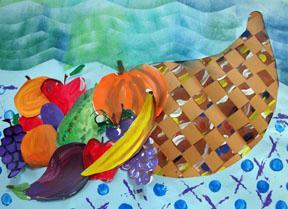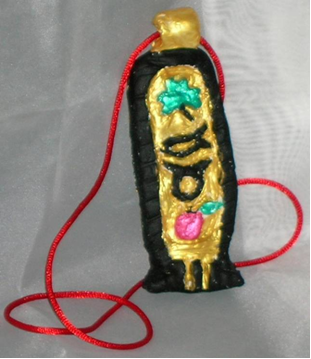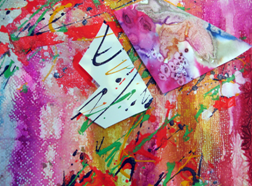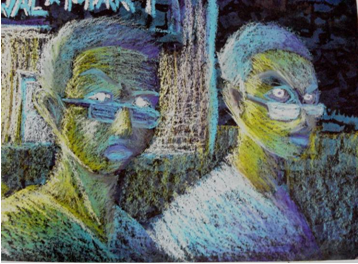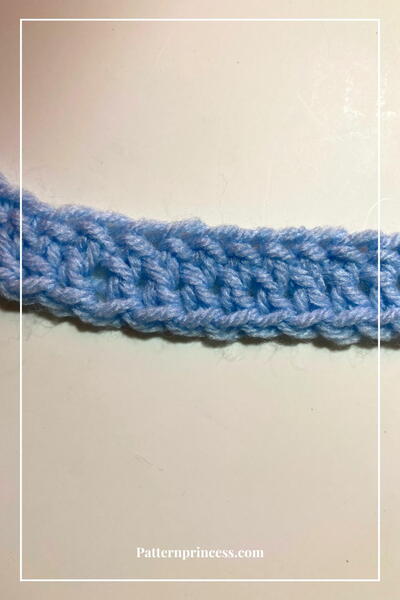Thanksgiving Cornucopia
Goal (Terminal Objective): Students will define weaving as an art form that can be both functional and decorative. Students will research fiber arts throughout history and in a wide variety of cultures. Students will research the symbolism of the cornucopia and its use as a Thanksgiving icon with this lesson from Sargent Art.
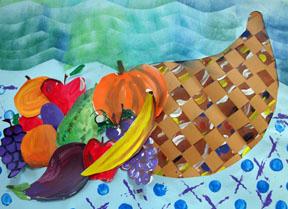
Objective: Students will become familiar with a variety of looms used in weaving. Students will explore ways that cultures use fiber arts for expressive purposes. Students will be able to identify and create pattern in a weaving. Students will become aware of the symbolic use of icons to note specific holidays. Students will study weaving as an art form by creating a woven component for a cornucopia and place it on a repeat printed background.
Target Grade: 5
National Standards:
- Visual Arts Grades 5-8 Content Standard 1: Understanding and applying media, techniques, and processes
- Visual Arts Grades 5-8 Content Standard 3: Choosing and evaluating a range of subject matter, symbols, and ideas
- Visual Arts Grades 5-8 Content Standard 5: Reflecting upon and assessing the characteristics and merits of their work and the work of others (Language Arts Cross Curriculum Connection)
Purpose: Students will become aware of variations of media, techniques, and processes used to investigate fiber arts as a functional and/or decorative art form.
New Vocabulary: loom, fiber, warp, weft, pattern, fiber artist, functional, decorative
Materials:
- Sargent White Glue
- Sargent Creative Craft Paint
- Sargent Chalk Pastels
- Sargent Paint Markers
- Construction paper
- objects for gadget printing
Time: This lesson may be modified from one to three hours, depending upon the size and complexity of expectations.
Introduction and Motivation (Set):
View a variety of examples fiber arts. Compare and contrast fiber art objects as to purpose, patterns, colors, texture, and possible cultural origins. Ask students to interpret objects viewed and discuss which have the most interesting patterns. Have students refer to the garments they are wearing and discuss possible ways the garments were constructed. Have students note patterns in their clothing. View early exemplars of weaving and discuss how yarn was formed from shearing, to carding and spinning.
View a variety of looms. Distinguish warp and weft on a loom.
Discuss the use of the cornucopia as a symbol of food and abundance dating back to the 5th century BC, also referred to as horn 'o' plenty, Horn of Amalthea, and harvest cone. Ask students to list icons of other holidays celebrated in this country. Show model and explain how students will create a similar art work.
Instruction:
Teacher will demonstrate the construction of a paper loom. Teacher will demonstrate using Creative Craft Paint and gadget print techniques to create weaving strip paper. Teacher will demonstrate using Sargent Paint Markers to create color effects on weaving strip paper. Teacher will demonstrate cutting the printed paper into strips and weaving the strips onto the paper loom. Teacher will demonstrate drawing and cutting out cornucopia shape on large construction paper and gluing in weaving. Teacher will demonstrate chalk rubbing and gadget printing on background.
Activities:
Guided Practice:
- Students create a paper loom using a 12” x 18” piece of brown or tan construction paper. Students will fold paper and then cut 1 inch strips from fold to 1 inch from the end.
- Students will use another piece of 12” x 18” brown or tan construction paper to create the weaving strips. Students will use Sargent Paint Markers to enhance the weaving strips.
- Students will allow weave strip paper to dry and then cut into one inch strips.
- Students draw the shape of a cornucopia in the center of an 18” by 24” piece of construction paper. Students may choose any color of 18” by 24” paper for this purpose.
- After cutting out the cornucopia shape, students apply glue to the top surface of the paper loom and glue it to the back of the cornucopia shape.
- Students use Sargent Paint Markers to create fruit and vegetables to be glued to the opening of the cornucopia.
- Students use Sargent Creative Craft paint to gadget print the base of the background paper simulating a surface such as a table.
- Students cut a wavy line on a scrap piece of paper.
- To make chalk rubbing background seen above the gadget print area, students apply a variety of colors of Sargent Square Chalk Pastels to the wavy edge of their scrap paper. Students place chalked scrap paper, wavy edge up on the cornucopia background and gently brush up the chalk onto the background using a cotton ball.
Independent Practice and Check for Understanding: Teacher circulates among working students visually recording students demonstrating understanding of objectives and provides reinforcement.
Closure: For the language arts connection, students will write a paragraph on an article of clothing in their closet, discussing its composition, possible way it was made, colors, textures, and patterns used in the clothing item.
Evaluation:
Level One--The finished Paper Woven Cornucopia collage very successfully demonstrates the student’s understanding of the weaving process. The student can successfully identify the use of the loom as well as the warp and the weft. The student can very successfully discuss the types of looms used by at least two cultures. The student can very successfully define functional art and decorative art and provide examples of each. The student can very successfully discuss the use of the cornucopia as a holiday icon and name icons associated with other holidays. The student has very successfully completed the closure writing component describing article of clothing in his/her closet, discussing its composition, possible way it was made, colors, textures, and patterns used in the clothing item. The student has used excellent craftsmanship and technical skill.
Level Two – The finished Paper Woven Cornucopia collage successfully demonstrates the student’s understanding of the weaving process. The student can successfully identify the use of the loom as well as the warp and the weft. The student can successfully discuss the types of looms in at least one culture. The student can successfully define functional art and decorative art. The student can successfully discuss the use of the cornucopia as a holiday icon. The student has very successfully completed the closure writing component describing article of clothing in his/her closet, discussing its composition, possible way it was made, colors, textures, and patterns used in the clothing item. The student has used good craftsmanship and technical skill.
Level Three--The finished Paper Woven Cornucopia collage adequately demonstrates the student’s understanding of the weaving process. The student can identify the use of the loom. The student can discuss the types of looms. The student can adequately define functional art and decorative art. The student can discuss the use of the cornucopia as a holiday icon. The student has adequately completed the closure writing component describing article of clothing in his/her closet, discussing its composition, possible way it was made, colors, textures, and patterns used in the clothing item. The student has used average craftsmanship and technical skill.
Level Four – The finished Paper Woven Cornucopia collage demonstrates minimal understanding of the weaving process. The student can not identify the use of the loom. The student cannot discuss the types of looms. The student cannot define functional art and decorative art. The student can not discuss the use of the cornucopia as a holiday icon. The student has not completed the closure writing component describing article of clothing in his/her closet, discussing its composition, possible way it was made, colors, textures, and patterns used in the clothing item. The student has used poor craftsmanship and technical skill.
Tips: In step #8, while the size of the scrap paper is not crucial, a 24” length of scrap paper with the wavy line cut across the long length makes chalk rubbing in one sweep without moving the scrap paper.
Notes: Fruits and Vegetables included in the cornucopia weaving collage may be built out in relief by adding small foam pieces behind the fruit.
Extension: Encourage students to create additional weavings using unusual looms.
Read NextAbstract Expressionism
Your Recently Viewed Projects
Marilyn B
Nov 14, 2017
As a former children's language therapist, this project and the detailed instructions and competency listings are super detailed! Adding some foam to the underside of the fruits is a great idea, but if foam isn't available, cotton balls or fiberfill would also work and may be a better medium for kids with motility or dexterity issues. This weaving pattern looks quite sophisticated and would make any parent, creator or recipient proud to own this work of art!
Report Inappropriate Comment
Are you sure you would like to report this comment? It will be flagged for our moderators to take action.
Thank you for taking the time to improve the content on our site.

